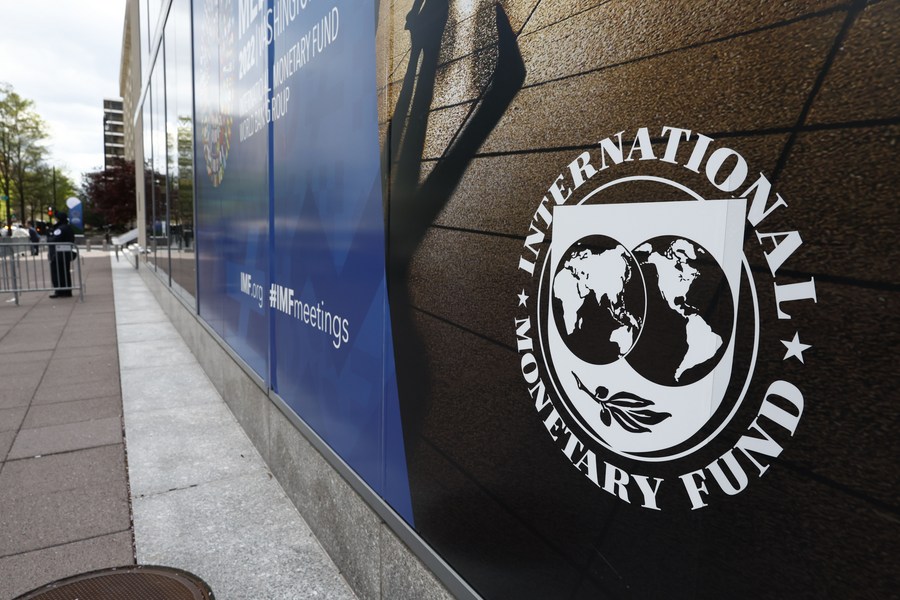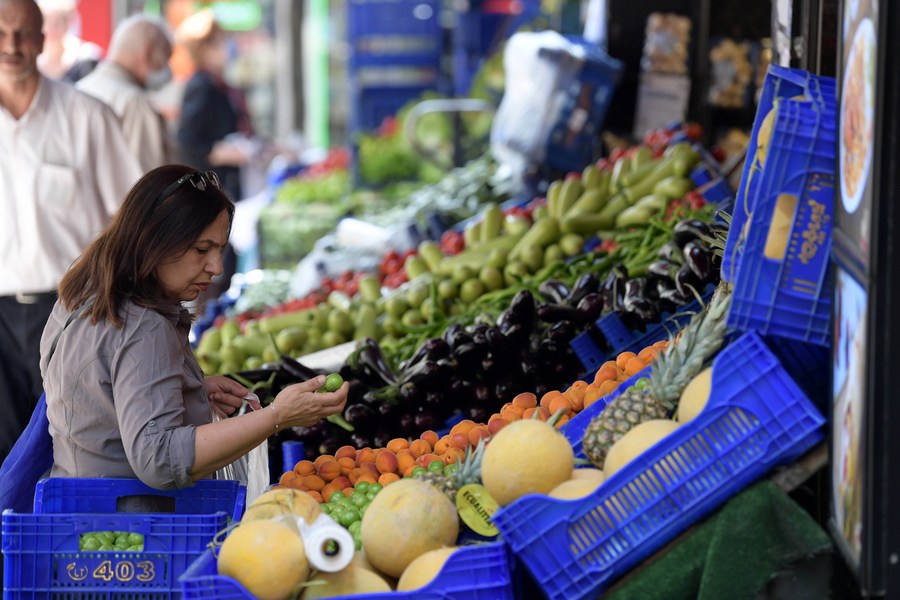IMF cuts 2022 global growth forecast to 3.2 pct, warns of downside risks

Photo taken on April 19, 2022 shows the IMF headquarters in Washington, D.C., the United States. (Photo by Ting Shen/Xinhua)
"Inflation has also broadened in many economies, reflecting the impact of cost pressures from disrupted supply chains and historically tight labor markets," IMF chief economist Pierre-Olivier Gourinchas said.
WASHINGTON, July 26 (Xinhua) -- The International Monetary Fund (IMF) on Tuesday slashed the global growth forecast for 2022 to 3.2 percent, down by 0.4 percentage point from the April projection, according to its newly released update to the World Economic Outlook (WEO).
Several shocks have hit the world economy already weakened by the COVID-19 pandemic, including higher-than-expected inflation worldwide -- especially in the United States and major European economies -- triggering tighter financial conditions, and further negative spillovers from the Ukrainian crisis, the WEO update said.
The global economy "is facing an increasingly gloomy and uncertain outlook," IMF chief economist Pierre-Olivier Gourinchas told a virtual press conference Tuesday, noting that many of the downside risks flagged in the IMF's April WEO have begun to materialize.
"Inflation has also broadened in many economies, reflecting the impact of cost pressures from disrupted supply chains and historically tight labor markets," he said.
Global inflation has been revised up due to food and energy prices, and is anticipated to reach 6.6 percent in advanced economies and 9.5 percent in emerging markets and developing economies this year -- upward revisions of 0.9 and 0.8 percentage point respectively, according to the WEO update.
In 2023, disinflationary monetary policy is expected to bite, with global output growing by just 2.9 percent, it said.
"There is one overwhelming priority at this point, and it is to bring back price stability in advanced economies and in emerging markets," Gourinchas told reporters.

A customer purchases vegetables at a stall in Istanbul, Turkey, May 26, 2022. (Xinhua/Shadati)
Going forward, it's very clear that the tightening by major central banks is going to have a continued effect on the rest of the world, he noted.
First, there's going to be reduced demand and economic activity at the global level, which will weigh on countries that rely a lot on the export sector for growth, he said.
Second, the tightening in the United States and other central banks is also leading to a major appreciation of the U.S. dollar against emerging market currencies, increasing inflation pressures in these countries, he said.
Third, there is a general tendency by investors to move away from emerging market economies and seek safe havens in a cycle like this, investing in U.S. treasuries or other safe assets, Gourinchas said, noting that there has been "persistent" capital flows moving out of emerging markets in the last four or five months.
"So things have not been too disorderly up until now, but of course we are concerned as to whether this might continue in the future," Gourinchas told reporters.
Gourinchas noted that the risks to the outlook are "overwhelmingly tilted to the downside."
Downside risks include: the Ukrainian crisis could lead to a sudden stop of European gas imports from Russia, inflation could remain stubbornly high if labor markets remain overly tight or inflation expectations de-anchor, or disinflation proves more costly than expected, and tighter global financial conditions could induce a surge in debt distress in emerging markets and developing economies, he explained.
The IMF chief economist urged countries to appropriately use macro-prudential tools to safeguard financial stability. "Where flexible exchange rates are insufficient to absorb external shocks, policymakers will need to be ready to implement foreign exchange interventions or capital flow management measures in a crisis scenario," he said.
Such challenges come at a time when many countries lack fiscal space, with the share of low-income countries in or at high risk of debt distress at 60 percent, up from about 20 percent a decade ago, he noted.

People eat pastas at a restaurant in Rome, Italy, on May 19, 2022. Italy's most traditional meal has been getting more expensive in recent months, and indications are that the trend is set to continue. (Xinhua/Jin Mamengni)
In a plausible alternative scenario where some of these risks materialize, inflation will rise and global growth will decelerate further to about 2.6 percent this year and 2 percent next year -- a pace that growth has fallen below just five times since 1970, he said.
"So 2 percent is really a sort of a low number for the global economy. That's a sense in which we're getting close, really close to a global recession," he told reporters.
Under this scenario, both the United States and the euro area will experience near-zero growth next year, with negative knock-on effects for the rest of the world, he added.
According to the WEO update, global trade is expected to grow by 4.1 percent in 2022 and 3.2 percent in 2023, down by 0.9 percentage point and 1.2 percentage points respectively from the April projection.
"This is a significant downward revision compared to our April forecast," Gourinchas said at the virtual press conference in response to a question from Xinhua. "In fact, it's even a larger revision than the decline in economic activity, which is not surprising because often global trade responds more than output."
The slowing in global trade growth reflects the decline in global demand, supply chain problems, as well as the U.S. dollar's appreciation in 2022. "Historically when the dollar is very strong with a lot of goods invoiced in dollars, it makes them expensive for importers," he said.
Going forward, the IMF chief economist said "we can anticipate that trade is going to rebound once we have a turnaround in economy activity and both demand stabilizes and supply expands, and then the dollar sort of stabilizes as well."
"We will have rebound in global trade and that may happen beyond 2023," he said.
Photos
Related Stories
- Interview: Thai central bank governor upbeat about China's growth outlook
- China's chemical fiber industry posts growth in revenue
- China capable of coping with the unexpected in meeting growth target: economic planner
- China achieves win-win situation for economic growth and environmental governance: Cameroonian student in China
- China takes prompt actions to stabilize growth amid tests
Copyright © 2022 People's Daily Online. All Rights Reserved.









